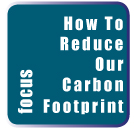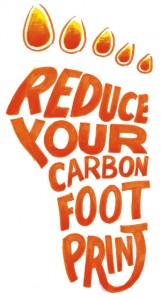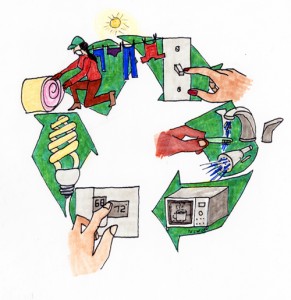 By Peter Bergel
By Peter Bergel
Helping you and encouraging you to cut your carbon footprint is a major purpose of OPW’s 5% Solution to the Climate Crisis project. In addition to the information provided in this PeaceWorker’s focus topic articles, you will find a great deal more about this subject on OPW’s website, www.oregonpeaceworks.org. On our homepage, click the 5% Solution link.
If you are wondering why a peace and justice organization like OPW is addressing global warming, the reasons are:
•   A main source of fossil fuel is oil — which produces global warming pollution when it is burned — is also at the root of many of the world’s wars.
•   Global warming, if it continues at current rates, will have enormous impact on the availability of many crucial resources, such as water, food and land, not to mention oil. As the population increases and these resources dwindle, more war is likely to be the result.
•   As some areas become unable to produce their own food, due to climate change, refugees will add to the pressure on others and conflicts will escalate toward violence.
•   Global warming is the greatest threat currently facing the earth and its inhabitants. No organization that works for peace can ignore such a threat.
The Basics
Energy generated by burning fossil fuels puts carbon dioxide (CO2) into the air. CO2 is the most prevalent of the “global warming gases.†It accumulates in the atmosphere and traps heat, which otherwise would be radiated into space. This causes the surface of the planet to warm up. A relatively small amount of warming is having an enormous impact on our climate, water supplies, sea level, agriculture and much more. Scientists have determined that no more than 350 parts per million (ppm) of CO2 in the air is climate-safe. We are currently at 387.
Remember: your biggest personal contributions to global warming come from these areas of your life:
•   How you transport yourself and your goods.
•   How and what you eat.
•   How you use energy around your home.
Therefore, these are the first areas to tackle as you reduce your carbon footprint.
Transportation
Cars release 98 tons of fossil fuels into the air for every gallon of gas.
•   Ride a bike or walk to work if you live close enough. Take a bus or train, if that is an option.
•   Make sure your car gets routine maintenance checks to extend its life and improve gas mileage.
•   Use cruise control on the highway to save gas. Keep speed below 60 mph.
•   Inflate your car tires to the recommended pressures.
•   Avoid unnecessary idling, excessive speeds and heavy braking.
•   Use the heating and cooling systems sparingly.
•   Plan trips to avoid traffic delays.
•   Consider buying a hybrid car, electric car, hydrogen car, biodiesel car or fuel cell car.
•   Limit or eliminate air travel, which requires enormous amounts of fossil fuel.
•   Visit http://www.greenstudentu.com/encyclopedia/energy/conservation for more suggestions.
Food
Eat local food: Find out where your food comes from. If it had to travel a long distance to reach you, it required energy for transportation and energy for refrigeration. If it is highly processed, each process required energy. If it was “factory farmed,†the tractors and machinery required a great deal of energy. If it was grown on land that formerly grew trees, those trees are no longer converting CO2 to oxygen.
•   Grow your own food, if you can.
•   Purchase locally-grown food, even if it is more expensive. Try restricting your food intake to products grown within 100 miles of where you live.
•   Seek organically grown food, which tends to use less energy in production, processing and packaging.
•   Refuse to purchase excessively packaged food. Let your market manager know why.
Eat lower on the food chain: If meat and dairy products are “factory farmed,†they are very wasteful of energy. Cows do not need to be fed grain, which is a valuable human food, but if they are, it takes many pounds of vegetable protein to produce a pound of meat or dairy protein. Cows that are fed grain also produce a lot of methane – a very potent global warming gas.
•   Eat less or no meat and dairy. Cutting out meat and dairy one or two days each week is very easy to do.
•   Purchase only locally-grown meat that is not grain-fed, or hunt your own meat.
Home Energy Use
Conserve: The best strategy is to use less and to use what you do use more efficiently. Eliminate energy waste. Improve your insulation, seal air leaks, don’t heat unused spaces.
Electricity Use: American households spend over $1,000 annually on electricity.
•   Almost half of the energy we consume in our homes is used for heat. Always check and replace your heating air filters and keep your thermostat at the lowest comfortable temperature.
•   Make sure your air conditioner is well-maintained and is the correct size for the area it is cooling. Turn it off when you’re at home and use fans for area cooling.
•   Always close your refrigerator door and keep the temperature between 36-38 degrees Fahrenheit.
•   Only wash heavily soiled clothing in hot water because 90% of the energy used goes to heat the water.
•   Turn off lights when you’re not using them and replace incandescent bulbs with compact fluorescent bulbs to use 75% less electricity. LED lights use even less.
•   Unplug appliances that are not being used because many draw “phantom†electricity to run unnecessary lights, clocks and displays. Consider buying more energy-efficient models; you may save money as well as energy in the long run.
•   For lots of other suggestions, visit http://green.wikia.com/wiki/How_to_reduce_your_carbon_footprint.
Water: Most people use 50-70 gallons of water every day in their homes. This water has to be pumped, heated and treated, and the waste water has to be pumped and treated as well.
•   Always turn off the running water when you are brushing your teeth, washing your hands or doing the dishes.
•   Wash only a full load of dishes in the dishwasher and let the dishes air dry.
•   Take fewer baths and shorter showers.
•   Only wash clothes when you have a full load.
•   Repair dripping faucets and toilet tank leaks.
•   Avoid flushing the toilet unnecessarily.
Visit the Energy Star website at http://www.energystar.gov/index.cfm?c=home_improvement.hm_improvement_index for more ideas and information. Don’t forget the 3 Rs: reduce, reuse and recycle. Φ
Peter Bergel is the Executive Director of Oregon PeaceWorks.
Illustration: http://guestofaguest.com/wp-content/uploads/2008/07/carbon.jpg
Cartoon: Courtesy of Natalie Whitson. This marks the 20th anniversary of Natalie’s involvement with The PeaceWorker. Congratulations, Natalie… and thanks!


2 comments for “Introduction to Cutting Your Carbon Footprint”